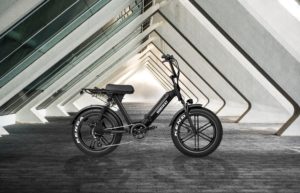How eco-friendly is the production of bikes and e-bikes in comparison to cars?
Photo by Himiway Bikes on Unsplash
We are all well aware of the benefits cycling can have, both on our physical health and the environment. Particularly for short to medium journeys, bikes are seen as a viable alternative to cars to help clean up the transportation industry’s carbon footprint. In day to day use, petrol and diesel cars will cause more harm to the environment than bikes and e-bikes, but how do the different modes of transport compare when it comes to manufacturing footprints?Â
As sales for bikes and e-bikes continue to rise, there is added pressure on manufacturers to adopt cleaner, more efficient production processes, since this is a particularly polluting part of their life cycles. Â
In this guide, we’ll compare the processes for each, and highlight ways they could be made more sustainable in order to go even further in helping to protect the environment.Â
The environmental impact of bike and e-bike productionÂ
The Bike Storage Company reports that the manufacturing footprint for bicycles is 96kg CO2e. In comparison, an e-bike has a slightly larger footprint at 134kg CO2e, with heavy machinery and the extraction of raw materials accounting for much of this figure.Â
However, it’s estimated that only around a quarter of cycling’s greenhouse gas emissions come from the manufacturing process. The rest comes from the additional food that’s required to ‘power’ cyclists and provide the energy needed to operate bikes. Despite the additional costs of needing to manufacture batteries, this means that the overall footprint of e-bikes is actually lower, as less ‘fuel’ is needed to power them.Â
The environmental impact of car productionÂ
The most significant environmental issue associated with car manufacturing is the release of carbon emissions. These emissions come from a variety of sources, including the burning of fossil fuels to power production facilities, the use of chemicals and manufacturing processes, and the disposal of waste products. Manufacturing just one small hatchback produces around 5.5 tonnes of CO2e – quite a leap from their two-wheeled counterparts.
In addition to carbon emissions, car manufacturing also results in the release of other pollutants, including particulate matter and toxic chemicals. These pollutants can damage air quality, water quality, and public health. As a result, it is important to consider the environmental impact of car manufacturing when choosing a vehicle.
How can we make production processes more environmentally friendly?
Whilst bicycles are more environmentally friendly than traditional cars, there are still a few manufacturing and production challenges that need to be addressed in order to cement them as a sustainable long-term solution. The first way we can make production processes more efficient is by reducing carbon emissions. This can be achieved through greater use of renewable energy sources such as solar and wind, and less reliance on harmful fossil fuels.
There could also be a greater shift towards using more recycled materials such as aluminium, to reduce the strain on the planet’s natural resources. With these measures in place, bikes and e-bikes could play a major role in reducing our environmental impact.
NEVER MISS ANOTHER NEWSLETTER!
LATEST BLOGS
Starbucks and Big Tobacco
Back in the 1950’s smoking was glamorous, and just about everybody who was anybody smoked cigarettes. Then came the discovery, to the shock of millions, that sucking smoke into your lungs might not be good for you. Then came another revelation that one of the substances in tobacco, nicotine, which was used as a poison by the Egyptians during the times of the Great Pyramids, is addictive. People then began a mass exodus from the consumption of nicotine via inhaled smoke.
Read MoreWal-Mart Goes Green – What about your company?
With the price of gas above $3.00, some companies (and hopefully all) are beginning to look at the fuel efficiency of their fleets. Wal-Mart is the most public example of this with its trucking fleet. Its efforts include:
Read More



